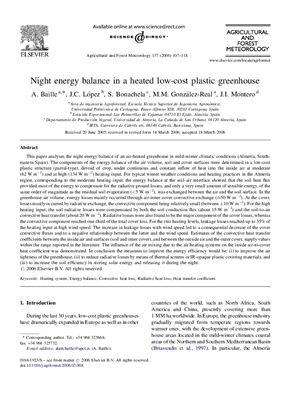На английском языке. Статья опубликована в ж. Agricultural and
Forest Meteorology, 2006, V.137 , P. 107–118.
Abstract. This paper analyses the night energy balance of an air-heated greenhouse in mild-winter climatic conditions (Almeria, Southeaste Spain). The components of the energy balance of the air volume, soil and cover surfaces were determined in a low-cost plastic structure (parral-type), devoid of crop, under continuous and constant inflow of heat into the inside air at moderate (62 W/m2) and at high (134 W/m2) heating input. For typical winter weather conditions and heating practices in the Almeria region, corresponding to the moderate heating input, the energy balance at the soil–air interface showed that the soil heat flux provided most of the energy to compensate for the radiative ground losses, and only a very small amount of sensible energy, of the same order of magnitude as the residual soil evaporation ( 5 W/m2), was exchanged between the air and the soil surface. In the
greenhouse air volume, energy losses mainly occurred through air-inner cover convective exchange (≈50 W/m2). At the cover, losses mostly occurred by radiative exchange, the convective component being relatively small (between ±10 W/m2). For the high heating input, the soil radiative losses were compensated by both the soil conduction flux (about 15 W/m2) and the soil-to-air convective heat transfer (about 20 W/m2). Radiative losses were also found to be the major component of the cover losses, whereas the convective component reached one-third of the total cover loss. For the two heating levels, leakage losses reached up to 35% of the heating input at high wind speed. The increase in leakage losses with wind speed led to a consequential decrease of the cover convective fluxes and to a negative relationship between the latter and the wind speed. Estimates of the convective heat transfer
coefficients between the inside air and surfaces (soil and inner cover), and between the outside air and the outer cover, supply values within the range reported in the literature. The influence of the air mixing due to the air heating systems on the inside air-to-cover heat coefficient was demonstrated. In conclusion the measures to improve the energy efficiency would be: (i) to improve the air tightness of the greenhouse, (ii) to reduce radiative losses by means of thermal screens or IR-opaque plastic covering materials, and (iii) to increase the soil efficiency in storing solar energy and releasing it during the night.
Abstract. This paper analyses the night energy balance of an air-heated greenhouse in mild-winter climatic conditions (Almeria, Southeaste Spain). The components of the energy balance of the air volume, soil and cover surfaces were determined in a low-cost plastic structure (parral-type), devoid of crop, under continuous and constant inflow of heat into the inside air at moderate (62 W/m2) and at high (134 W/m2) heating input. For typical winter weather conditions and heating practices in the Almeria region, corresponding to the moderate heating input, the energy balance at the soil–air interface showed that the soil heat flux provided most of the energy to compensate for the radiative ground losses, and only a very small amount of sensible energy, of the same order of magnitude as the residual soil evaporation ( 5 W/m2), was exchanged between the air and the soil surface. In the
greenhouse air volume, energy losses mainly occurred through air-inner cover convective exchange (≈50 W/m2). At the cover, losses mostly occurred by radiative exchange, the convective component being relatively small (between ±10 W/m2). For the high heating input, the soil radiative losses were compensated by both the soil conduction flux (about 15 W/m2) and the soil-to-air convective heat transfer (about 20 W/m2). Radiative losses were also found to be the major component of the cover losses, whereas the convective component reached one-third of the total cover loss. For the two heating levels, leakage losses reached up to 35% of the heating input at high wind speed. The increase in leakage losses with wind speed led to a consequential decrease of the cover convective fluxes and to a negative relationship between the latter and the wind speed. Estimates of the convective heat transfer
coefficients between the inside air and surfaces (soil and inner cover), and between the outside air and the outer cover, supply values within the range reported in the literature. The influence of the air mixing due to the air heating systems on the inside air-to-cover heat coefficient was demonstrated. In conclusion the measures to improve the energy efficiency would be: (i) to improve the air tightness of the greenhouse, (ii) to reduce radiative losses by means of thermal screens or IR-opaque plastic covering materials, and (iii) to increase the soil efficiency in storing solar energy and releasing it during the night.

